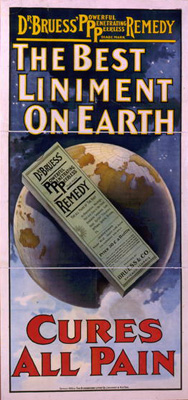
A Growing List of Coronavirus Scams
A master list of known and alleged scams.
The polio vaccine, penicillin, open-heart surgery, magnetic resonance imaging, chemotherapy, Zoloft, LASIK, statins, heck, even Viagra have all contributed to the advancement of modern medicine. We’ve come a long way from leech therapy, opium tinctures, and the age of ineffective and dangerous “snake oil” therapeutics. Or have we?
The truth is that we still face a nearly constant litany of infomercials, print ads, e-mail spam, pop-ups, and banner ads every day, promoting unregulated hokey miracle cures and sure-fire remedies for everything from arthritis and balding, to cancer and AIDS.
Even the benefits of legitimate, FDA-approved drugs are prone to hyperbole in the slick marketing campaigns put on by the titans of the pharmaceutical industry. One study shows that major drug makers make $4 for every $1 that they spend on direct-to-consumer marketing. Now you can understand why there are so many drug ads on TV these days.
Prescription medicine and its associated advertising are supposed to be tightly regulated by the FDA. New prescription treatments require pre-market approval for safety and effectiveness, and undergo years of testing. Ads for prescription medication are required not only to educate consumers about product benefits, but also provide information on side effects and adverse reactions. But even some big pharma companies play fast and loose, and create ads that are deceptive and misleading in order to push sales of their products:
Example 1: Latisse
The FDA found ads for Latisse, a prescription remedy for “inadequate or not enough lashes,” featuring The magic dust that turns any commercial for a product into a veritable event that allows us to transcend our normal, everyday lives and take us away to an existence of utter beauty, complete comfort, enormous homes, and luxurious cars. Not. spokesperson Brooke Shields to be misleading for failing to adequately warn users about potential side effects, including permanently changing your eye color. Whoa, that’s one heck of a side effect!
Example 2: Celebrex
The FDA slapped Pfizer on the wrist in 2004 for their print and TV ads for Celebrex, a pain relief drug used to treat conditions such as arthritis. The ads were found to “contain misleading claims of safety and unsubstantiated claims of superiority and effectiveness and also omit material facts, including indication and risk information.” The FDA required that Celebrex and all makers of steroidal anti-inflammatory drugs change their labeling to include a boxed warning highlighting the potential of increased cardiovascular events.
To check if the FDA has taken any action against prescription medication advertised in the media you can search the agency’s website.
A master list of known and alleged scams.
Company had claimed the key ingredient in its “system of protection” was proven to “kill” the coronavirus.
TINA.org investigation also finds sellers using the FDA’s logo in violation of the agency’s logo policy.


